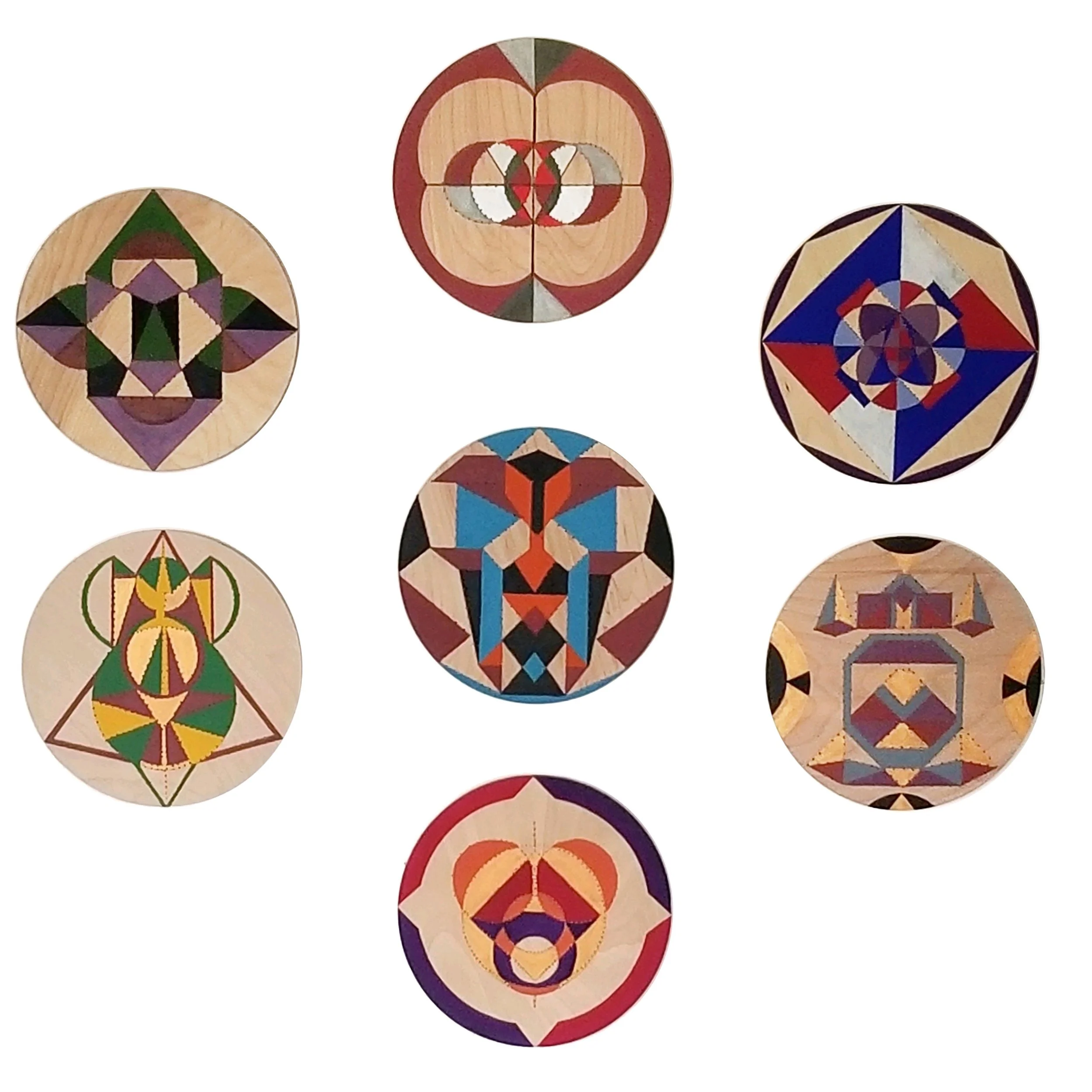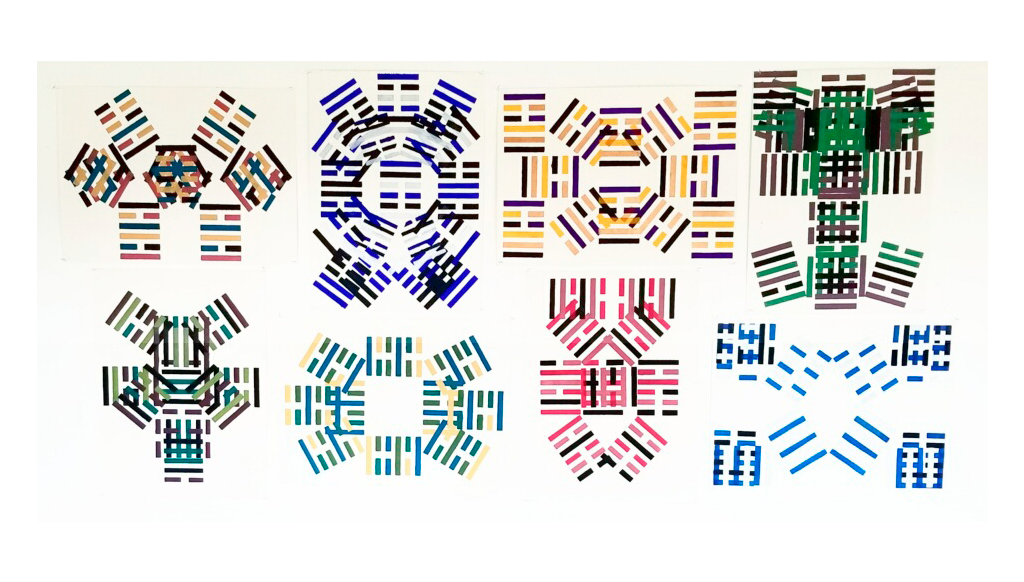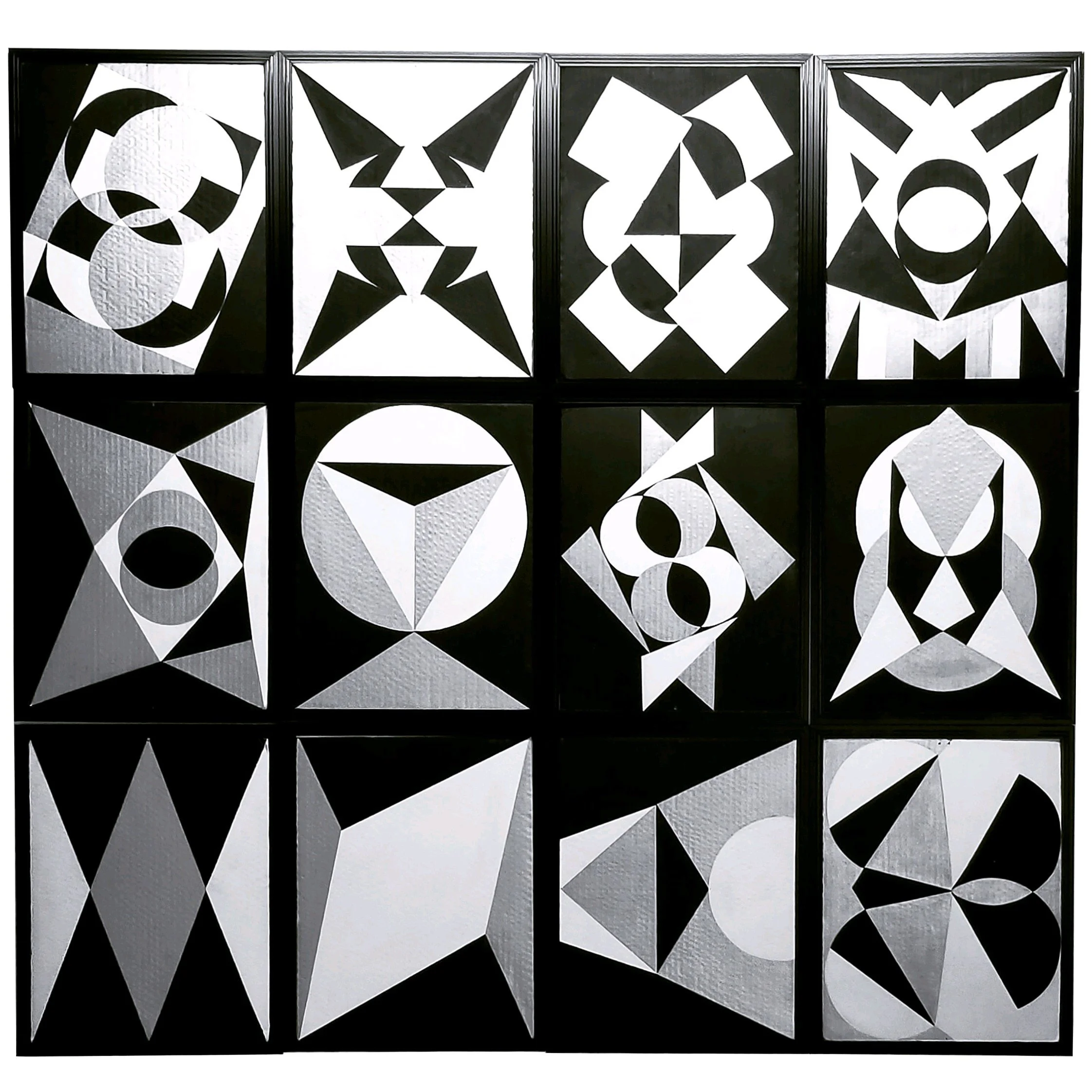Francine Hunter McGivern
Francine Hunter McGivern’s recent and exquisite work is included in the exhibition, Between the Cracks at Hudson Hall in Hudson, New York, curated by artist, Reginald Madison. This is the last weekend to see the show! It closes November 17th.
Holey Tondos (series) 2023, Hand punctured gouache on birch panel, each 12 × 12 inches.
We would like to take this opportunity to publish an extract of art critic, writer and poet, Carter Ratcliff’s essay on Francine’s work, An Art of Everything with a link to the entire essay.
Francine Hunter McGivern : An Art of Everything by Carter Ratcliff
For five decades, Francine Hunter McGivern has made art in such an astonishing variety of mediums, modes, and styles that one cannot easily say what kind of artist she is. Much less can we define her with any confidence, for it is impossible to find a single presence anywhere in a body of work that is geometric one moment, gestural the next, and includes photographic self-portraits that throw the very idea of a fixed identity up for grabs. Her elusiveness recalls the sea god Proteus, who delivers his prophecies only to those who manage to capture him—a difficult task because he is fluid, like the sea itself, and his shape constantly changes. Ultimately, though, Hunter McGivern is not protean but manifold, a distinction that surfaces only after a long immersion in her art. But where to plunge in? I’m going to start, almost at random, with a recent series of works on paper entitled Progressive Pattern.
Progressive Patterns, 2021, Series of eight works. Gouache on Fabriano paper, Each 20 × 30 inches
Installation view in Linlithgo, NY photo credit: Alon Koppel
The process invoked by the title is guided by the I Ching or Book of Changes, an ancient Chinese method of divination. Hunter McGivern begins by throwing three coins, thus determining the choice of one of 64 hexagrams: stacked combinations of six lines, some broken and some solid. She does this several more times, selecting by this chance method the hexagrams to be stenciled onto a sheet of paper. Usually, the next step in the process is to consult a guide to the concepts attached to each of the hexagrams and try to grasp the meaning of their interplay. For all we know, Hunter McGivern does this. What we know for certain is that she intervenes at this point, arranging the hexagrams according to her own purpose—repeating them, tilting them, layering them. These procedures result in symmetries, striking and rendered all the more powerful by the patterned play of color the artist adds to each hexagram. From the I Ching, Hunter McGivern generates images with overtones of modernist painting’s geometric wing. Yet a crucial difference should be noted.
Piet Mondrian, Kazimir Malevich, Hilma af Klint, and other geometric abstractionists nearly always produced compositions: pictorial structures that bring an array of disparate form into a harmonious and asymmetrical balance. The forms in Hunter McGivern’s Processive Pattern series are identical and thus demand to be deployed not compositionally but symmetrically. The vertical and occasionally horizontal axes around which her hexagrams organize themselves establish bilateral structures like those of our bodies. It is not that Processive Pattern works represent the human body, as so many of Hunter McGivern’s earlier works do. Rather, these works have a formal—even a conceptual—affinity with our physical forms. Further, the more complex configurations in this series have postures and some even seem to gesture. Ordinarily, the I Ching is impersonal, offering its commentary on human affairs across distances enforced by randomness. The Processive Pattern works imbue the I Ching’s hexagrams, however obliquely, with a human presence.
…Read the entire essay here with installation images on Daniel Rothbart’s website.
Compossibilities, 2020, Gouache on corrugated cardboard, Each 14 × 11 inches.
About:
Francine Hunter McGivern’s work embraces a range of ideas grounded in a Post-Conceptual practice that includes performance, video, text, multi-media installations, drawing, painting, and sculpture.
Inspired by Warhol’s Factory, Hunter McGivern opened Jungle Red Studios in1977. Under the nom d’art, Jungle Red, she developed experimental work in theatre, performance, and cabaret and is acknowledged as an “infamous” member of the New York underground of the late 1970s and through the1980’s. Notorious for her sophisticated style, witty demeanor, and design skills, Jungle Red was highly sought after by high-profile players in art, music, fashion, and media. Her extensive contemporary art collection speaks to her role as muse to close friends, collaborators, and artists who also define the “Downtown” decade.
Living in Positano from 1989 to 1998, the artist was inspired by life amid the powerful volcanic energy fields on the Amalfi Coast, consequently developing a varied and unique vocabulary for framing spaces and materials that have evolved into her present practice.
Diagnosed with epilepsy at age six, Hunter McGivern began counting interior gridded forms as a simple methodic exercise to perceive and map spatial delineation, thus locating her physical form in the spaces between. The out-of-body seizures guided her lifelong research into the Hermetic in art and philosophy. Metaphysics, geometry, physics, and mathematics are germinating ciphers that continue to determine and shape the artist’s practice.
In 2011, Hunter McGivern rebuilt a 15000 square foot building in Linlithgo NY and founded CR10Arts; a five-year conceptual curatorial project investigating the role of the Kunsthalle in the 21st Century. Grounded in “practice | process| form | archive” and inspired by Gordon Matta Clark’s “Anarchitecture”, one hundred artists were invited to create site-specific installations and performances. The CR10Arts project and the Jungle Red Studios archives are at present housed in The Frank Institute @ CR10 where Hunter McGivern has her studio.
You can also see prints of Francine’s earlier work on Peat and Repeat’s website.
Between the Cracks at Hudson Hall features Reginald Madison’s work alongside Hudson Valley artists Ntchota Drippy Badila, Marlene Marshall, Rik Letendre, Randall Schmit, Lyle Ashton Harris, Francine Hunter McGivern, Shanekia McIntosh, Sedat Pakay (1945-2016), Kianja Strobert, and Lenox, MA-based artist Jim Youngerman.
UPCOMING: Essays and Interviews
Part II of Interview with Elke Luyten.
Interview with Anna Sang Park on her trilogy The Cho Stories
Interview with Coder/Herbologist/Film Ace, Artist and Poet, Meredith Finkelstein
PEAT and REPEAT BOOK SERIES:
Peat and Repeat is excited to announce that we are creating an artist book series that will include programming and workshop endeavors. We are launching a fundraising initiative for this series. More on this soon.
We really do rely on tax-deductible donations to keep going! The more we can fundraise the more projects in the community we can produce and our intention is to expand our community outreach.
Caterina Verde’s, Mole Mansions will be the first to emerge from this series. Expected due date December 2024



